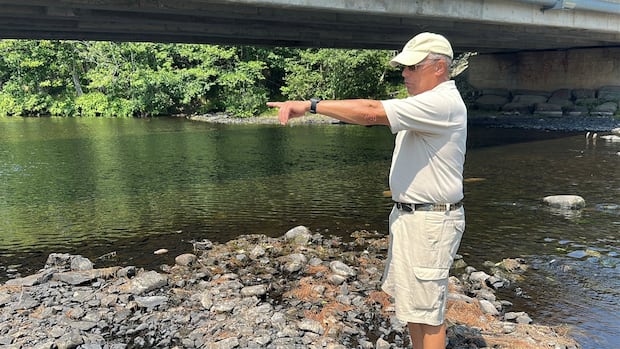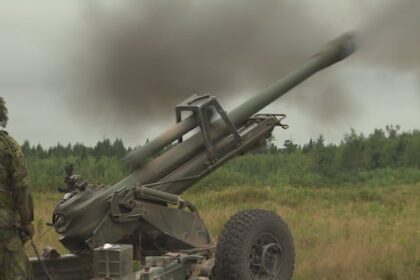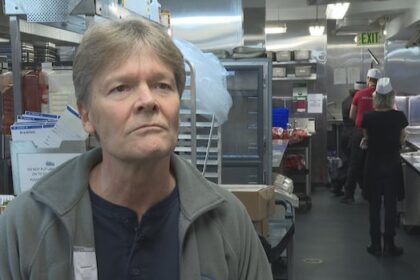Nova ScotiaLower than normal rainfall totals, combined with hot, humid weather, have led to tinder dry conditions throughout central Nova Scotia, where people are being asked to preserve water and water delivery businesses are stretched thin.’I haven’t seen it this dry this early,’ East Hants councillor saysGareth Hampshire · CBC News · Posted: Jul 29, 2025 11:52 AM EDT | Last Updated: 38 minutes agoEast Hants Coun. Norval Mitchell points to the bank of the Shubenacadie River by Enfield where water levels would generally be. He is standing on the river bed which he said is not normally possible this time of year. (Gareth Hampshire/CBC)Lower than normal rainfall totals, combined with hot, humid weather, have led to tinder dry conditions throughout central Nova Scotia, where people are being asked to preserve water and water delivery businesses are stretched thin.With water levels of Colchester County’s St. Andrews River at its lowest since monitoring began 10 years ago, the town of Stewiacke is asking people in the area to save their water.”The low river levels make it difficult for us to draw and treat the water,” said Stewiacke Mayor Doug Glasser.In a notice posted on the town’s website, it’s asking residents to limit lawn watering to one day a week, restrict the watering of plants and stop washing outdoor surfaces such as decks, sidewalks and driveways.”We’re not telling people not to use water. We’re asking them to be responsible,” Glasser said, adding his own lawn has never been as brown as it is now in 18 years and what is needed is some rain.Conditions are similar in nearby communities, which are also seeing an unusually dry July following lower than expected rainfall in May and June.”This is really dry and I haven’t seen it this dry this early,” said East Hants Coun. Norval Mitchell.No restrictions have been implemented in East Hants just yet, but that could change, Mitchell said, with levels in the Shubenacadie River also low in some areas.”We’d like the people to be proactive, to start to conserve, even though it’s not required,” Mitchell said. “It’s good that we get into practice when conditions are this dry.”Water delivery business boomingMeanwhile, water delivery companies in the region have been inundated with calls from people hoping to get their wells filled.”Wells are drying up big time,” said Raymond Bellefontaine with J & B Water in Shubenacadie. “We just can’t keep up.”Raymond Bellefontaine with J & B Water says he’s been getting calls from across the region. (Gareth Hampshire/CBC)Bellefontaine said the company has received calls from within their local area to as far away as Debert, about 40 kilometres away.Within the first two hours of Monday morning, he said, 34 voicemails and texts had piled up.”There is no end in sight,” he said.Another water company, Maritime Clean and Care Ltd. near Elmsdale, has had a similar experience. Owner Tammie Isenor said the business has been operating every day since mid-June and running 12-15 hour days to meet the demand.A water distribution station in Enfield, N.S., has also seen trucks continually re-filling their tanks in recent days.Rainfall amounts lower than normalIan Hubbard, a meteorologist with Environment and Climate Change Canada, said the area is on track to receive about a third of the amount of rain it would normally record in July. His analysis comes from measurements taken from the weather station at the nearby Halifax Stanfield International Airport, which has gathered precipitation amounts since 1953.”This is actually on track to be the third driest July of all time,” Hubbard said. “It definitely seems to be the [month] that’s going to have the driest of all the stations that we look at.”He said less than 30 millimetres of rain has fallen at the airport so far this month, adding a normal July would see about 86 millimetres.”It’s been an exceptionally dry month and also a couple of months in a row now dating back to May,” Hubbard said.Some of the rain that has fallen has also come from thunderstorms, Hubbard said, which happen quickly so the water doesn’t have time to absorb into the ground.The parched conditions also follow a fall and winter that saw drier than normal months in October, November and January.”We’ve been looking at a deficit for many months now,” he said.With temperatures in the 30 C range and a heat warning in place, the conditions are likely to continue into August, he said.ABOUT THE AUTHORGareth Hampshire began his career with CBC News in 1998. He has worked as a reporter in Edmonton and is now based in Halifax.
Some Nova Scotians asked to conserve water amid ‘exceptionally dry’ July











